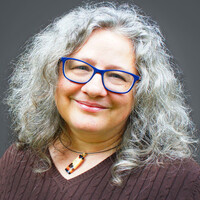This is a pretty cool building. Who was the Architect?
News Analysis
Social Resilience and Equity in the Heart of Cleveland
Editor’s note: This project will be featured at the first national conference on resilience in the built environment taking place November 7 and 8 in Cleveland. Join BuildingGreen, the International Living Future Institute, and the Resilient Design Institute there for Building Resilience 2019. Building Resilience 2019 will focus exclusively on how to create more resilient buildings and communities. Conference attendees will have opportunities to participate actively in professionally facilitated, outcome-focused working sessions. Learn more at buildingresilience.living-future.org.
This waiting room at the center features ample daylight, an important resilient design element.
That’s the message of Matthew Gray, chief of sustainability for the City of Cleveland. Gray is referring to a specific project in the Hough (pronounced “huff”) neighborhood of Midtown—the LEED Platinum-certified University Hospitals Rainbow Center for Women and Children, designed by Moody Nolan. “This neighborhood in transition is at a critical point,” he told BuildingGreen. A “leading-edge” building like this, he said, is a vital part of the neighborhood “transforming itself to lead with resilience and connectivity.”
A healthy community
As a healthcare facility, the Rainbow Center’s first priority is its patients. It offers a unique wellness model that connects women and children with myriad related resources beyond primary medical care. These resources include onsite access to dietitians, a vision clinic, dental services, a pharmacy, financial planning, utility assistance, and legal services (for example, to help parents whose children have been exposed to lead). University Hospitals even tapped a local grocery chain, Dave’s Supermarket, to attract it to the neighborhood so that patients would have next-door access to fresh food as well as a cooking classroom. A food bank distributes free produce once a week.
University Hospitals works with more than 35 local organizations to achieve all this, even convincing the transit authority to re-route one of its lines to drop patients off closer to the center.
Beyond meeting the holistic needs of individual patients, the goal was “to make the center building itself part of a healthy community,” said Aparna Bole, M.D., division chief of general academic pediatrics & adolescent medicine at University Hospitals. “It’s some about the physical infrastructure”—like energy efficiency, bike storage, passive solar design, multimodal transportation, and onsite solar panels that provide half of the building’s electricity—“but also about the social fabric.”
Social resilience
Just as the holistic healthcare model of the center expands naturally into public health goals, like reducing Cleveland’s staggering infant mortality rate (14.9 per 1,000 births), so do the building’s sustainability and resilience features expand to the entire community. The approach fits in with the city’s neighborhood-by-neighborhood resilience strategy, according to Gray. Rather than one-size-fits-all city-wide model, the city’s resilience plan differs according to each community’s needs.
And the Rainbow Center is meeting the very particular needs of Hough, says Bole. But that doesn’t mean the ideas can’t be implemented in other communities. “I think that the model of designing programs that are responsive to community needs … those concepts are replicable.”
Aside from furthering physical resilience with features like walkability, bikeability, and transit access, the Rainbow Center furthers social resilience, says Bole. “I think that resilience is about preserving well-being even amid stress, and the net of social capital is part of that,” she told BuildingGreen. “The social net is stronger if we know one another and share information.”
Healing a racist legacy
Sited in a transitional neighborhood, the center aims to bring vibrance and social resilience.
Bole said it’s important to note that the center, with 17,000 patients, has a much larger catchment area than the Hough neighborhood itself. “Our services touch families from all over the region,” she said. Attracting this large patient base can play an important role in increasing neighborhood viability.
“Hough is infamous as one of the spots for race riots 50 years ago,” Bole said. “Cleveland is famously segregated.” (Hough is primarily African American.) She added that discrepancies in health outcomes between blacks and whites reflect this legacy of segregation in housing. “This economic transition can really be inclusive and just, and build wealth that’s sustainable for the residents who’ve always been here. Those health disparities are crises. Investing in resilience-building in this neighborhood is really important.”
For more information:
University Hospitals
uhhospitals.org
Correction: This article was updated to reflect a corrected infant mortality rate. It is not 14.9% but 14.9 per 1,000 births.
Originally published September 27, 2019 Reviewed October 7, 2019 Permalink Citation
Melton, P. (2019, October 7). Social Resilience and Equity in the Heart of Cleveland. Retrieved from https://www.buildinggreen.com/news-analysis/social-resilience-and-equity-heart-cleveland




Add new comment
To post a comment, you need to register for a BuildingGreen Basic membership (free) or login to your existing profile.